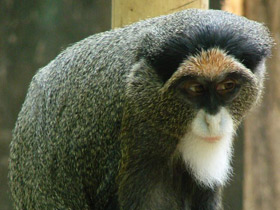De Brazza's monkey (Cercopithecus neglectus)
De Brazza's monkey видео
De Brazza's monkey (Cercopithecus neglectus) is an Old World monkey endemic to the riverine and swamp forests of central Africa. The largest species in the guenon family, it is one of the most widespread arboreal African primates. Aside from size, it can be differentiated from other cercopithecus monkeys by its orange diadem and white beard. Due to its cryptic nature, the species is not well documented in all of its habitats but has shown unique traits such as pair-bonding and aggressive behavior towards other guenons.
Etymology
Locally known as swamp monkeys, these primates are named after the Italian naturalist and explorer Jacques Savorgnan de Brazza. Their scientific species name, neglectus, which means to pay no attention to, was given to them because of their ability to hide from both humans and predators.
Appearance and habitat area
The Brazza cercopithecus, bishop monkey or swamp guenon (Cercopithecus neglectus) is a species of catarrhine primate of the family Cercopithecidae. Cercopithecus neglectus is distributed from northern Angola, Cameroon, Equatorial Guinea and Gabon westwards to Uganda, Kenya and southeastern Ethiopia.
These monkeys can be found in the upper levels of tropical forest, but also use other habitats: shrub thickets, bamboo groves, arid montane forests and tall grass wetlands. These monkeys are named after the Italian Count Pierre-Paul-François-Camille Savoignan de Brazza (1852-1905), who discovered them.
Because of their inconspicuous colouring, Cercopithecus neglectus are adept at hiding in foliage. When in danger, they stay in place, a characteristic that forms the basis of their name: the word "neglectus" is derived from the verb "neglego", meaning "to look through the fingers" or "to neglect".
Cercopithecus neglectus is a medium-sized animal, with females measuring 39-54 cm in length and males 48-59 cm and tails 47-78 cm. Weight of females: 4.4 kg; weight of males: 8 kg. Cercopithecus neglectus has a white beard on the muzzle and a brown or orange patch on the forehead with a black stripe along the brow line, while in males the skin on the cheeks around the nose is blue.
Behaviour and reproduction
Cercopithecus neglectus live in monogamous families or family groups consisting of one adult male, three adult females and their young. The monkeys are active during the day and spend most of their time in trees. In case of danger, they prefer to hide rather than fight. Cercopithecus neglectus feeds on young leaves and fruits, as well as flowers, insects, bird eggs and small vertebrates. They are silent monkeys, rarely screaming and using rich facial expressions to communicate.
Pregnancy in Cercopithecus neglectus lasts 5-6 months and a young is born. Sexual maturity is reached at the age of 3-5 years.
Predators
Predators of the De Brazza's monkey include the crowned eagle, leopard, humans, and common chimpanzees. Though rare, dogs and pythons may also predate on juvenile De Brazza's. The typical predator response is to curl up in a tight ball against the side of a tree with the orange crown and white stripes on the thighs hidden and wait silently for the predator to leave. Individuals will only move if the predator approaches their position, and even then they move quietly and slowly to try and escape notice.
Conservation
The De Brazza's monkey is listed as least concern by the IUCN Red List. The main threats to DeBrazza's monkeys are deforestation due to logging and agriculture, and bushmeat hunting. There are several captive population housed in zoos across Europe and North America. The Association of Zoos and Aquariums (AZA) manages captive population under a species survival plan. This is unique because the species is not listed as vulnerable or endangered, but has been sponsored by the AZA to proactively prevent need for reactive conservation in the future. More data is needed to fully assess the conservation needs of this species.











































